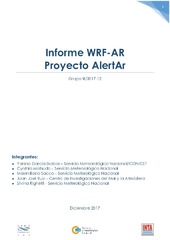Mostrar el registro sencillo del ítem
Informe WRF-AR Proyecto AlertAr
| dc.contributor.author | García Skabar, Yanina | |
| dc.contributor.author | Matsudo, Cynthia Mariana | |
| dc.contributor.author | Sacco, Maximiliano | |
| dc.contributor.author | Ruiz, Juan José | |
| dc.contributor.author | Righetti, Silvina Andrea | |
| dc.date.accessioned | 2018-10-05T14:28:13Z | |
| dc.date.available | 2018-10-05T14:28:13Z | |
| dc.date.issued | 2017-12 | |
| dc.identifier.uri | http://hdl.handle.net/20.500.12160/785 | |
| dc.description | Informe del Proyecto AlertAr del Grupo III/2017-12 | es |
| dc.description.abstract | Una de las herramientas que se utilizan para pronosticar eventos meteorológicos de alto impacto asociados a tormentas son los pronósticos numéricos y en particular aquellos que cuentan con una resolución que permite resolver adecuadamente los procesos atmosféricos en la mesoescala. Dichos procesos están frecuentemente asociados con la ocurrencia de fenómenos meteorológicos de alto impacto como precipitación intensa, vientos fuertes, etc. Una mejor representación de los procesos atmosféricos en mesoescala, ayuda a identificar de manera más precisa las situaciones sinópticas que pueden devenir en la ocurrencia de dichos fenómenos. En ese sentido se desarrolló un sistema de pronóstico operativo con el modelo de mesoescala Weather Research and Forecasting Model (WRF) aumentando la resolución espacial y temporal de los pronósticos numéricos respecto a las disponibles hasta el momento en la región. El objetivo del presente informe es documentar las características del pronóstico numérico generado con el modelo WRF-ARW en alta resolución que se encuentra implementado en una fase semi- operativa desde enero de 2017 y actualmente está en su fase final de pase a operaciones. | es |
| dc.description.abstract | Numerical forecasts represent a very useful tool to forecast high-impact weather events associated with storms and in particular those that have a resolution that allows to properly solve atmospheric processes in the mesoscale. These processes are frequently associated with the occurrence of high impact weather phenomena such as intense precipitation, strong winds, etc. A better representation of mesoscale atmospheric processes helps to identify in a more precise way the synoptic situations that can trigger the occurrence of these phenomena. In this sense, an operational forecast system was developed with the mesoscale model Weather Research and Forecasting Model (WRF), increasing the spatial and temporal resolution of the numerical forecasts with respect to those available so far in the region. The objective of this report is to document the characteristics of the numerical forecast system generated with the WRF-ARW model in high resolution that is implemented in a semi-operational phase since January 2017 and is currently in its final phase to be operational. | en |
| dc.language.iso | spa | es |
| dc.publisher | Servicio Meteorológico Nacional. Gerencia de Investigación, Desarrollo y Capacitación. Departamento de Investigación y Desarrollo. | es |
| dc.subject | EVENTOS METEOROLÓGICOS DE ALTO IMPACTO | es |
| dc.subject | PRONÓSTICO NUMÉRICO | es |
| dc.subject | WRF | es |
| dc.subject | WRF-ARW | es |
| dc.title | Informe WRF-AR Proyecto AlertAr | es |
| dc.type | Other | es |
